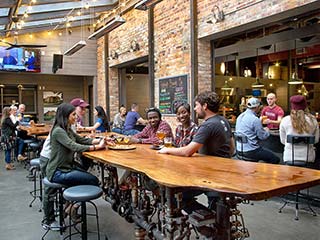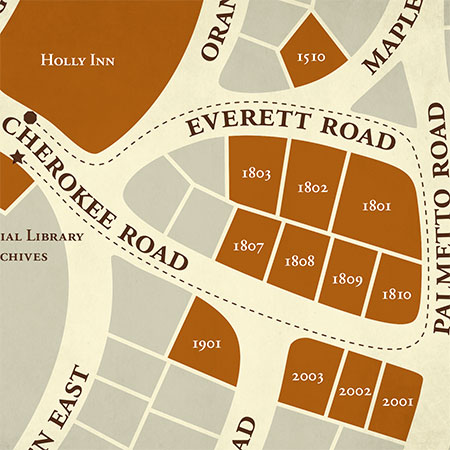Locker Room Talk
by Lee Pace
Locker Room Talk
For the golf purist, the fascination is endless. The pristine new World Golf Hall of Fame located on the second floor of the USGA Experience Building in Pinehurst includes 5,400 square feet of space, 170 lockers representing the inductees since its opening in 1974 and some 3,000 display artifacts.
Of course, there are plenty of golf clubs on display — the wooden shafted clubs that Sam Snead played as a boy, the irons Johnny Miller used to shoot 63 in winning the 1973 U.S. Open at Oakmont, the first steel-headed driver used in winning the U.S. Open when Curtis Strange wielded a MacGregor Muirfield driver in 1988-89.
And there are a lot of trophies — a dozen at present with two more soon to come, representing every major championship in American golf for men and women as well as team competitions like the Ryder Cup and Solheim Cup.
But the true allure is a slow stroll through the aisles of lockers and a close examination of the artifacts and pieces of memorabilia the inductees and/or their families have provided for display.
There are a pair of boots still laced with dirt and mud that golf architect Pete Dye wore schlepping through golf course construction sites and a cigar chomped on by Charlie Sifford in notching 22 professional wins.
There is the typewriter Henry Longhurst used in composing his essays for the London Sunday Times, the cassette tapes of Herbert Warren Wind’s conversations with luminaries like Ben Hogan and a display of books that emanated from the fertile and funny mind of Dan Jenkins.
There are nine Bibles tucked into the lockers. In Betsy King’s space, a Bible is the only artifact, and it’s opened to her favorite verse, Titus 3:15: “All that are with me salute thee. Greet them that love us in the faith. Grace be with you all.”
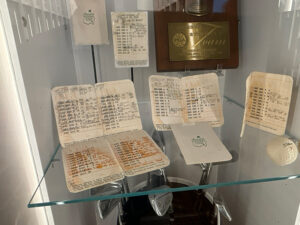
Raymond Floyd Scorecards
There are items of clothing — an orange silk shirt that Chi Chi Rodriquez wore during a career that included winning eight PGA Tour events; the maroon shirt adorned with U.S. Ryder Cup team portraits that Ben Crenshaw outfitted his players in on that memorable Sunday of the 1999 Ryder Cup at Brookline; the Army jacket that Larry Nelson wore serving in Vietnam in the late 1960s. There is a Purple Heart positioned in Lloyd Mangrum’s locker, a keepsake from being wounded by shrapnel in Germany in 1945.
Many of the displays pay tribute to members’ hobbies. Tony Jacklin is accomplished at marquetry, the art of inlaying pieces of wood to create a picture, and his self-portrait hangs in his locker. Davis Love III is a voracious reader and a dozen books are displayed in his space, including one on barbecue and a Stephen King novel. There is a soccer ball in Bernhard Langer’s locker, a cricket bat in Colin Montgomerie’s and a fishing rod and box of lures in Mark O’Meara’s.
Several players have contributed scorecards from major victories, cards that are interesting not because of a number made on the holes but the golfer’s meticulous hand-written notes on measurables like yardage, slope and wind direction. Raymond Floyd’s locker includes Augusta National scorecards that Floyd used when winning the 1976 Masters.
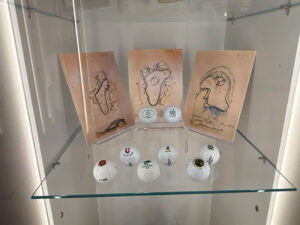
Dr. Alastair Mackenzie Hole Diagrams
Golfers seem to have a particular fondness for the game of baseball. Floyd was offered a pro contract by the Cleveland Indians before his pro golf career commenced in the mid-1960s, and he was a huge Chicago Cubs fan. His locker includes a Louisville Slugger baseball bat given to him by the Cubs. You can find ball caps from the Kansas City Royals (Tom Watson), Boston Red Sox (Pat Bradley) and Detroit Tigers (Meg Mallon). Babe Zaharias’s artifacts include her vintage baseball glove, a tribute to the sport she first loved and where she earned her nickname by hitting five home runs in one game.
Golf architecture buffs will enjoy perusing the locker of Donald J. Ross, where they can see some club making tools from the early 1900s as well as a compass, slide rule and pair of bifocals. A walking stick that A.W. Tillinghast used trouping through his job sites is on display as are three drawings from Alister Mackenzie’s pad and pen of green complexes from his creation at Pasatiempo in Santa Cruz, Calif.
And there are seemingly arcane displays such as a saucepan in Karsten Solheim’s locker. Solheim as a young man sold pots and pans for Miracle Maid Cook-Ware and groomed the entrepreneurial spirit that led to founding the PING manufacturing company.
“It’s really a great portal into the lives of these golfers,” says Mike Trostel, the director of the World Golf Hall of Fame. “When Hale Irwin came through, the one club that he talked about the most was a cut-down club that he used when was six, seven, eight years old. He accomplished so much to get into the Hall of Fame, and here is this club he used as a boy, when it all started.”
“I hope that people learn that there are so many diverse players and contributors to the World Golf Hall of Fame,” adds Hilary Cronheim, the USGA staffer who directed the design and contents of the USGA Experience and World Golf Hall of Fame. “You may not know all the names of the members, but they are all deserving of that honor. Mostly I hope that through the artifacts in the lockers that people leave feeling better connected to a certain member or moment.”
Curtis Strange is among the inductees who’ve seen the new facility, checking it out the week of the U.S. Open in June.
“Pinehurst has always been one of my favorite places in golf, and it’s great to see the Hall of Fame re-established there,” Strange says. “They have done a terrific job. Walking through the Hall and seeing and feeling the history of the game is special.”
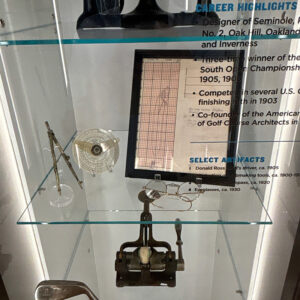
Donald Ross Artifacts
Trostel says the USGA staff has been heartened by the warm welcome the Hall of Fame has received from locals and traveling golfers since it opened in June. The staff is looking for ways to evolve the programming, and one concept in the
planning stages is inviting Hall of Fame members to visit Pinehurst for speaking engagements at the facility. The Hall of Fame was also approached by the family of Rodriquez, who died in August at the age of 88, about holding a “celebration of life” event at the Hall of Fame. The facility will be closed on November 9 for that memorial.
“His family reached out and said the Hall of Fame was so important to him and was one the greatest accomplishments in his career. He was so proud of that,” Trostel says.
The museum is open seven days a week from 10 a.m. to 5 p.m., with general admission priced at $10. North Carolina residents can enjoy a discounted rate of $5, and USGA members and children 12 and under are offered free admission. The facility is located at 3 Carolina Vista Drive in Pinehurst, just steps away from the main Resort Clubhouse.
For more information, click link: https://www.usga.org/content/usga/home-page/golf-house-pinehurst.html


